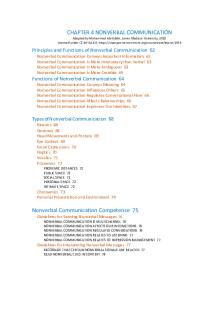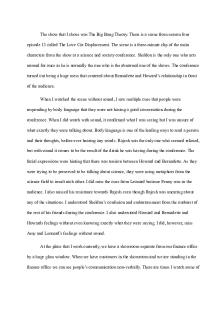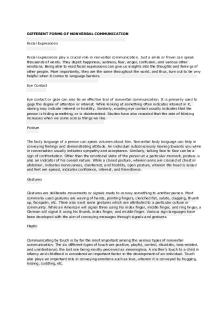Power Cues by Nick Morgan Summary-Master Nonverbal Communication PDF

| Title | Power Cues by Nick Morgan Summary-Master Nonverbal Communication |
|---|---|
| Course | Business Communication |
| Institution | Lahore University of Management Sciences |
| Pages | 7 |
| File Size | 213.2 KB |
| File Type | |
| Total Downloads | 44 |
| Total Views | 156 |
Summary
To be a great leader you need to align your unconscious power cues with your
conscious content
• Improving yourself first requires self-awareness
• Isolate your subconscious fears, then repeat opposite mantras over and over for a few
months
• Voice might the most powerf...
Description
Cues: Summary & Review in PDF
Title: Power Cues Author: Nick Morgan Genre: Business & Economics Publisher: Harvard Business Press Release Date: 2014 Pages: 262 Power Cues takes a holistic view of communication. Nick Morgan, the author, writes one of the best books at the intersection of social power, body language, and effective leadership.
Bullet Summary • • • •
To be a great leader you need to align your unconscious power cues with your conscious content Improving yourself first requires self-awareness Isolate your subconscious fears, then repeat opposite mantras over and over for a few months Voice might the most powerful tool of power
Power Cues Summary Nick Morgan categorizes the power cues in 7 major categories:
1. Become Self-Aware
Before you can even think about fixing your current issues and upgrading yourself, you must know yourself. These are some of the questions Nick Morgan proposes: how are you showing up in your conversations, your meetings, and your presentations? Are you powerful and commanding? Are you friendly and warm? Do people fear you, trust you, like you, avoid you, flock to you? What happens? Do you take charge or take a backseat? And here are the best takeaways from this chapter: • • • • • •
Gestures and verbal communication are two separate communication channels Gestures precede words by splits of a second You must make the two go in sync or you look scatterbrained and uncharismatic Record yourself and get a full grasp on what you’re communicating (or hire me and I’ll help you) Don’t talk while using slides in your presentation (reading slides and listening to you taxes two different part of the brains and you’ll lose the audience) Use gestures or your brain has to work much harder
2. Master Nonverbal Communication It’s difficult to fully control our body language, and that’s why we should focus on the emotions instead. Then the body language comes out naturally. The author says that most of us are not charismatic because we don’t focus our emotions. We interact with people with a hundred different things going through our minds and we present a mixed bag of emotions. We are like cluttered to-do lists. And a cluttered mind results in muddled interactions, which are charisma-murderers. When we can manage to muster a certain emotion, not only we are charismatic, but thanks to mirror neurons we will be able to make people feel the same (original research on mirror neurons here, but the research has been heavily criticized). • • • •
You can work from emotions to gestures (inside out approach) Or from gestures to emotions (inside in) The best approach is working on both at the same time Pick a time when you felt like a winner, then use all five senses to put yourself back in that moment
•
• It’s easy for some, but not for others: practice until it becomes easier You just need to evoke the emotions, not the specific gestures • This is the sequence: emotions lead to gestures; body language leads to conscious thought
How to increase your charisma: 1. Increase your authenticity (words and body language in sync) 2. Increase your passion 3. Focus on the moment
3. Learn to Read Others’ Unconscious Messages We make decisions at an emotional, unconscious level first, and only later we rationalize. When you need to learn the subtle signs of others, you will be able to see where they are going before they are even fully aware of it. You are already able to read other people but only at an unconscious level. To make the most out of it, you need to bring that awareness to your conscious mind first. Once you become conscious about the messages you are sending and the messages other are sending, you will be able to act upon earlier and you will be able to focus on what you want to pay attention to. Once you become good at it, you don’t need to constantly pay attention to it anymore. They will become part of who you are and you can send them back to your unconscious once again. •
Gestures are fluid and ambiguous, analyzing them one by one is meaningless (the author mentions “Undercover Sex Signals“)
The Four Constellations of Body Language The author mentions Paul Ekman and his research in micro-expressions. Learning to decode micro-expressions take a long time though, and he proposes an alternative by focusing on four basics tells of interpersonal interactions. There are four core constellations of body language you should be paying attention to: 1. 2. 3. 4.
Power Friendship Alignment Lying
The author discusses each and the propose you recruit your own unconscious mind for the answers. The correct way to asking questions to your subconscious is through simple, polar questions. For example: is this person friend or foe? Is this person telling the truth or lying? Is this person on my side or not? Is this person powerful or not? After you ask those questions, empty your mind and let the answer come to you. This, too, is a skill which takes practice.
4. Master The Power of Your Voice This was one of the best and most eye-opening chapters of Power Cues for me. Here is what the author says: people who put out the right kind of sounds—below the range of conscious human hearing— become the leaders of most groups. We defer unconsciously to leaders who have stronger low-frequency sounds. And here is the good news: You can learn to increase the leadership potential of your voice through breathing and other vocal exercises, and practicing the authoritative arc. And then goes on to mention the study: When Stanford and his colleague dug into the Larry King interviews, they found that lowerstatus people match the low-frequency sounds of the higher-status people in the room. We get together, we start talking, and in a couple of minutes, we’ve unconsciously picked a leader and lined up behind him or her. A study also found out how voice pitch, and particularly deeper pitches, predicted elections results every time in the past 100 years. Does that mean that lower pitches always win? No, not necessarily. You need a mixture of both highs and lows to make your voice clear and resonant. The author talks about finding your MRP, such as the point of your voice where you maximize both overtones and, most importantly, undertones. A bathroom with all its hard porcelain surfaces is a good place to practice working on your MRP.
To find the right voice tone, practice moving up and down through your vocal range until you find that pitch that seems to echo throughout your head and the room. That’s the pitch that maximizes the subsonic frequencies and will thus enhance your leadership power. To see how this works in practice, study—yes—President Ronald Reagan’s voice. It’s a perfect leader’s voice; it oozes resonance and authority with every phrase. (what you need is) the resonance that will give your voice authority. Then he says that Reagan here maximizes his MRP and whenever he changes pitch, he always goes back to his MRP. Don’t force yourself to go lower or higher as that will strain your vocal cords and can harm them for good. Some people will find it easy to control their voice, while some others must work harder at it.
5. Combine Voice & Body Language Body language and voice must be in sync to influence. There are four patterns of behavior that, when well managed, allow you to influence people: 1. Influence—how much one person dominates the conversation (increase positional power, emotion, or expertise, or control the give-and-take tempo of the conversation) 2. Mimicry—how much one person mirrors another (start by mirroring them, then have them follow you) 3. Activity—how energetic a person is. 4. Consistency—how even-keeled a person is (the higher the consistency and the more steadfast you remain to your ideas in spite of what people throw at you, the more powerful you appear). However, as I also explain in Social Power, you don’t always want to be consistent and refuse other people’s input when it’s out of place. Speaking to a client, a higher variation in your manners shows that you’re open to them.
6. Learn to Effectively Use Your Intuition This chapter gets you to work on your unconscious and to resolve your fears. 1. 2. 3. 4.
Identify your fears as clearly as you can Write them down (if it hurts and you feel it deep inside you’re doing it right) let them sit a few days and go back to them a few times during the day Come up with counter-statements about the new you that you want (use only positive sentences, make it as precise and simple as possible with subject and verb) 5. Write it down, let it sit for at least twenty-four hours 6. Imagine this sentence were true: would your life improve? If so, you’re doing it right
7. Now repeat yourself this line as often as possible, and especially before sleep, right after you wake up and, most of all, any time the old doubts and fears creep up It will take some time. From a few weeks to a few months. But keep at it with the same level of intensity.
7. Get Minds In Sync: Use Stories Great leaders are storytellers. And great leaders don’t tell stories that makes them sound great. They tell stories that make others feel like the most important heroes of the story. The authors say that you should decide on the level to which you want to engage your audience and introduce the Maslow’s hierarchy (stay at the lower levels of safety if you want a visceral reaction). And then you should pick one of stories archetypes, which are: setting off on a quest, stranger in a strange land, love story, rags to riches, and revenge. The author also explains how to set them up, particularly the “hero on a quest”, which is so ingrained in our culture we don’t even recognize it anymore as a story archetype.
Real Life Applications •
Don’t talk while projecting slides
Simple, yet such a game changer. •
Practice managing your own states
The typical “Tony Robbins exercise” of changing your states by recollecting of a time when you felt great doesn’t come easily to many but by practicing it will get easier •
For presentation get an “off-stage beat”
Nick says that businesspeople and presenters who find and objective and get into a positive emotion do much better. It might be something like: While you’re breathing before the meeting, get an objective and an emotion into your head. “I can’t wait to tell these people about my special new idea and I’m thrilled to the max to see them.” You will also have less time to make yourself nervous. •
Keep elbows away from the body
Some people gesture with their lower arms only, and it looks defensive and unconfident. Push the elbows out and gesture with your whole body. •
Reading a person based on wrinkles
The author looks for wrinkles on people’s forehead. If they have, that means they were open to new ideas and concepts. A smooth forehead means they have been closed down most of their lives. •
Prepare!!
This is the biggest takeaway really. When you don’t reheard your “first-timers” cue overlap with the cues of people who don’t fully mean what they say. To make sure that your verbal and nonverbals are congruent and aligned you need to know your material and what you’re going to say. Then you make it seem like you’re going impromptu...
Similar Free PDFs

6 - Nonverbal Communication
- 1 Pages

Chapter 4 Nonverbal Communication
- 19 Pages

CH 5 HW: Nonverbal Communication
- 2 Pages

Communication skills by Kitonka
- 55 Pages

Softball Cues Study Guide
- 2 Pages

Essay - Power by Audre Lorde
- 2 Pages
Popular Institutions
- Tinajero National High School - Annex
- Politeknik Caltex Riau
- Yokohama City University
- SGT University
- University of Al-Qadisiyah
- Divine Word College of Vigan
- Techniek College Rotterdam
- Universidade de Santiago
- Universiti Teknologi MARA Cawangan Johor Kampus Pasir Gudang
- Poltekkes Kemenkes Yogyakarta
- Baguio City National High School
- Colegio san marcos
- preparatoria uno
- Centro de Bachillerato Tecnológico Industrial y de Servicios No. 107
- Dalian Maritime University
- Quang Trung Secondary School
- Colegio Tecnológico en Informática
- Corporación Regional de Educación Superior
- Grupo CEDVA
- Dar Al Uloom University
- Centro de Estudios Preuniversitarios de la Universidad Nacional de Ingeniería
- 上智大学
- Aakash International School, Nuna Majara
- San Felipe Neri Catholic School
- Kang Chiao International School - New Taipei City
- Misamis Occidental National High School
- Institución Educativa Escuela Normal Juan Ladrilleros
- Kolehiyo ng Pantukan
- Batanes State College
- Instituto Continental
- Sekolah Menengah Kejuruan Kesehatan Kaltara (Tarakan)
- Colegio de La Inmaculada Concepcion - Cebu









